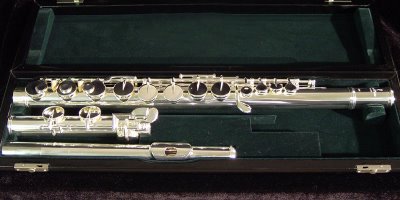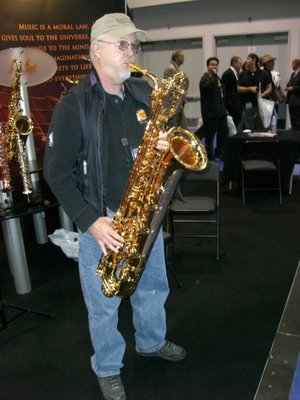
OK. I know what you're thinking. I fought this battle too. I can still hear my wife echoing in my head, in reply to the merest suggestion that an alto flute might be a excellent purchase. There was always some kid expense, house expense, or simply expense standing in the way, and then there was the deal-breaker. "When," she'd ask, "was the last time someone called you for a gig on alto flute?"
Point taken, sails (and sales) deflated. My wife's mastery of the calculus of money is not to be trifled with. She is, in fact, a professor of accounting at one of the great business schools in America. She knows her stuff. But you can overdo this way of examining life's little issues. There's a certain madness in adding instruments to a collection like mine, but they all have to pay their own way with gigs, and each one of them was added at some level by impulse.
And so it came to be that I cast my net. I looked at three altos, and I'll tell you in the fullness of time, which one I decided on and why, and what justification arose for its purchase.
I love Tony Campise's alto flute, almost as much as I love Tony. It plays effortlessly because of the design by the legendary Speedy Tanaka and sold as a DiMedici by Jupiter. It has three nice octaves, but, with a silver head joint, alas it was a little beyond the budget at over $3000. (The one I played without a sterling headjoint felt a little stuffy.) At $40 a casual or $100 a recording track, that's a long time in paying it off. Besides, I already have a perfectly good C flute and a piccolo and each of them handles those stratospheric ranges. Actually Tony's alto flute may be exceptional because he's an endorser, and endorsers tend to get the pick of the litter.
Nevertheless, the DiMedici had excellent ergonomics, and that makes a big difference when you're slinging one of these heavy (Hah! Am I really saying that? Me with the bass saxophone?) pipes around. It's very hard to balance the instrument in a playing position if there's no comfortable finger position to begin with. For example, my friend Ginger has a very nice Armstrong that she's owned since the early eighties. It's another swell instrument, but the thing is so uncomfortable that Imy hands and shoulders start cramping up when eight bars has passed.
I spent the last year or two trying out sub-$3500 altos: Emersons, the house model from the Woodwind/Brasswind, Gemeinhardt, Armstrongs . . .
Now I'll tell you what I bought.
I got a Pearl from Nations of Music, an online dealer that also handles Steve Goodson Model and Saxgourmet saxophones. And the one I got has a Sterling silver lip plate and not much else. The high range is pretty good and it doesn't fade to a whimper until A3. The ergonomics are very nice, with a comfortable hand position. As I said, no Sterling excelpt the lip plate, everything else is silver plate.
One characteristic of Pearl flutes is pinless construction. I think most of us just accept that there will be these pins in our flutes assaulting us and our clothing at all times. This alto flute even has French pointed arms, a very nice touch.
Details abound with this instrument. The French style case and fleece-lined case cover are very attractive and protective.
So how much for this superb piece of work? The Pearl 201s is just $1,450 out the door, half my budget.
Now let's get to the musical justification for owning this instrument. Say you're on a casual. You're doing an hour of cocktail music before the rest of the band saddles up. The folks want to do some talking among themselves, so you've been instructed to maintain "conversational levels," whatever that means nowadays. But the bass player plays too loud, up creep the drummer and piano player, and before you know it everybody's yelling to be understood.
Here's what you do: pull out the alto flute and play a couple ballads. You will lead the rest of the band into coversational levels once again. And if you happen to have the Pink Panther theme in your book, so much the better.
Nations has a complete selection of Pearl alto flutes.
Go to
this link to see.
 Here's a picture of Tom Scott playing the new SG Baritone Sax at winter NAMM last week, when we were having our little ice storm here in central Texas.
Here's a picture of Tom Scott playing the new SG Baritone Sax at winter NAMM last week, when we were having our little ice storm here in central Texas.

